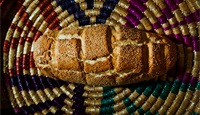
Applicants:
Kilani Villagers Association, Omodos Community Council
Communities concerned – Bearers of the element:
Kilani and Omodos Community Councils.
Kilani Villagers Association, local small “arkatena” artisanal rusks industries, Kilani and Omodos inhabitants – bearers of the knowledge of making “arkateno”.
Domain of Intangible Cultural Heritage:
Traditional craftsmanship
Date of inscription:
2015
Geographical location and range of the element:
The craft of preparing the so-called “arkatis” (special chickpea yeast) and the “arkatena” artisanal rusks starts from Kilani and Omodos, the two villages supplying the yeast to other neighbouring villages for the production of the “arkatena” artisanal rusks. It is also present in other wine villages of the mountainous Limassol area as well as in villages in the district of Pafos.
Brief Description:
“Arkatena” are a type of artisanal rusks which are made using yeast from the foam rising during the fermentation of chickpeas, known as “arkatis”. The name “arkatis” is probably derived from the Greek word εργάτης [ergatis] meaning “labourer” referring to the long process for producing this particular yeast which lasts a whole night and requires a lot of patience.
First of all the spices - ginger, cinnamon, nutmeg, laurel and others - are placed in a glass jar with a wide mouth. Crushed chickpeas and hot water are added on top of the spices. Then, the jar is placed in a basin, is covered with straw and a woollen fabric and is kept like this for six hours. It is necessary to place it in a warm environment and this is probably why in the old days the “arkatena” rusks used to be made only around the 15th August for the day of the Assumption of Mary. After many hours, the foam rising at the top is collected three times and is placed in a bowl where the dough is prepared. The rusks are formed and placed in the oven. The “arkatena” rusks can be eaten either as soft bread “poxamathkies”) or as “twice-baked bread” (“xerathkiasta” or rusks).
The connoisseurs in the production of the “arkatis” yeast avoided revealing the secrets of the trade, as they believed that the yeast would lose its power and would fail to rise. Apart from the secrecy kept in the preparation of the yeast, the fact that the chickpeas used to be milled in an anticlockwise direction and that the yeast had to be prepared at midnight shows that there was an effort to apply magic in the process in order to ensure absolute success in the yeast production.
Beyond their use as part of the daily diet in the Kilani and Omodos communities, the traditional “arkatena” artisanal rusks were directly linked to the customs of the cycle of life, as they were used during joyful and mournful events as a token of hospitality, donation or charity and also in the context of religious rituals and ceremonies. At weddings “arkatena” rusks used to be offered often with wine during the groom and bride’s bath, the adorning of the future newly-weds, the preparation of a special dish known as “resi” and the sawing of the matrimonial bed. The birth customs also included the preparation of “arkatena”, which mothers would exchange as gifts with fellow villagers. At funerals and memorial services “arkatena” rusks are still offered today with or without halloumi cheese. Finally, the “arkatena” rusks are also a must during religious feasts which shows that people feel the need to make an offering of “arkatena” to the Virgin Mary, to Jesus Christ and to the Saints.